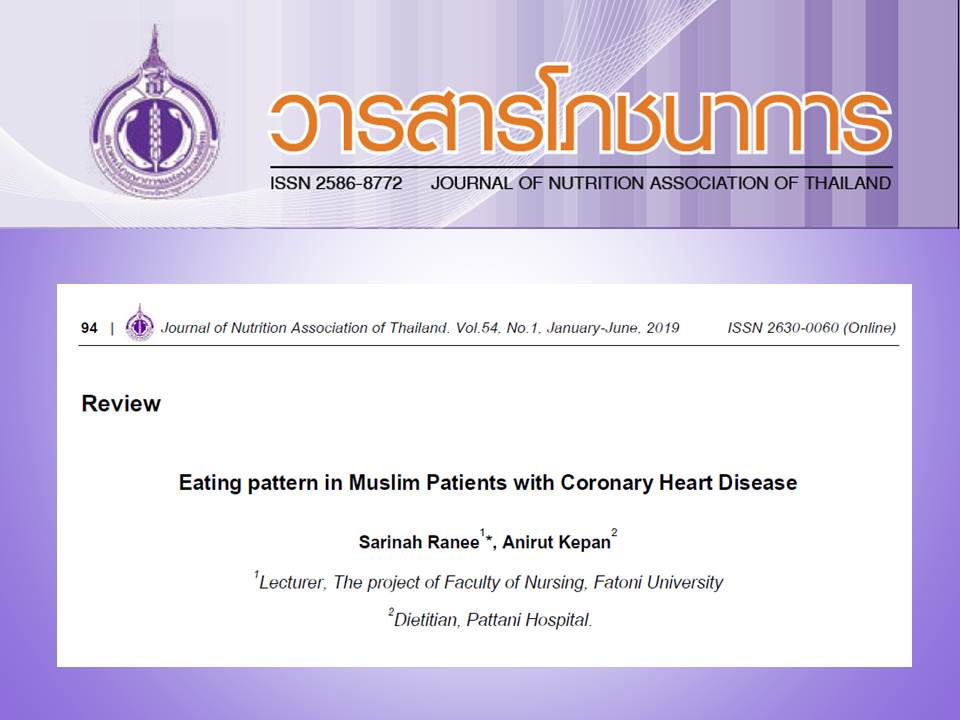Eating Pattern in Muslim Patients with Coronary Heart Disease
Keywords:
การรับประทานอาหาร, โรคหลอดเลือดหัวใจ, มุสลิมAbstract
Coronary heart disease has the highest mortality rate in Thailand and the world. It is found that Islamic people are more likely to suffer from coronary heart disease than those who are Buddhist. Patients with coronary heart disease have already been treated. Can return to be repeated. If not reduce risk factors. Eating behavior and lifestyle changes. Traditional Thai folk food customization is in line with the TLC diet, reducing the consumption of saturated fat, trans fat, and increasing vegetables and fruits, nuts, whole grain cereals, fish, lean meat, low-fat dairy products and vegetable oils are the main targets for reducing LDL cholesterol. Reduce the risk of coronary heart disease. And reduce the occurrence of severe complications of coronary heart disease.
References
2. สำนักนโยบายและยุทธศาสตร์ สำนักงานปลัดกระทรวงสาธารณสุข. จำนวนและอัตราตายด้วยโรคหัวใจขาด. 2559.
3. Suwatanaviroj T, Yamwong S. Prevalence of coronary artery disease in different ethnic groups at a tertiary care hospital. J Med Assoc Thai. 2013; 96(10):1298-1301.
4. Black JM, Hawks JH. Medical-Surgical nursing: Clinical management for positive outcome St. Louis, MO. 2010: Elsevier Saunders.
5. อัจษรา บุญมีศรีทรัพย์, อาภรณ์ ดีนาน, กนกนุช ชื่นเลิศสกุล. ปัจจัยทำนายพฤติกรรมการรับประทานอาหารเฉพาะโรคของผู้ป่วยโรคหลอดเลือดหัวใจ. วารสารคณะพยาบาลศาสตร์ มหาวิทยาลัยบูรพา. 2552;17(3): 41-53.
6. De Souza RJ, Mente A, Maroleanu A, Cozma AI, Ha V, Kishibe T, et al. Intake of saturated and trans unsaturated fatty acids and risk of all cause mortality, cardiovascular disease, and type 2 diabetes: systematic review and meta-analysis of observational studies. BMJ. 2015;351.
7. กองสุขศึกษา กรมสนับสนุนบริการสุขภาพ เเละกระทรวงสาธารณสุข. การปรับเปลี่ยนพฤติกรรมการบริโภคอาหารสำหรับวัยทำงาน. 2558.
8. ยูซูฟ นิมะ, สุภัทร ฮาสุวรรณกิจ. การเเพทย์เเละการดูเเลผู้ป่วยที่สอดคล้องกับวิถีมุสลิม. สงขลา: สถาบันวิจัยระบบสุขภาพภาคใต้ หาวิทยาลัยสงขลานครินทร์. 2551.
9. ดวงตา สุวรรณรัตน์, เพลินพิศ ฐานิวัฒนานนท์, ไหมไทย ศรีแก้ว. ผลของโปรแกรมการปรับเปลี่ยนพฤติกรรมร่วมกับกลุ่มประคับประคองพฤติกรรมการควบคุมปัจจัยเสี่ยงด้านโภชนาการของผู้ป่วยโรคหัวใจขาดเลือด. วารสารพยาบาลศาสตร์ จุฬาลงกรณ์มหาวิทยาลัย. 2552;21(2): 122-138.
10. ปาริชาติ คงเสือ, ปชาณัฏฐ์ ตันติโกสุม, นรลักขณ์ เอื้อกิจ. ผลของโปรแกรมการพยาบาลแบบสนับสนุนและให้ความรู้ต่อพฤติกรรมการรับประทานอาหารของผู้ป่วยโรคหลอดเลือดหัวใจหลังได้รับการขยายหลอดเลือดหัวใจ. วารสารเกื้อการุณย์. 2557;21:168-184.
11. อิสมาอีลลุตฟี จะปะกียา. คู่มือผู้ป่วยและการจัดการตามหลักการอิสลาม. ยะลา:มหาวิทยาลัยอิสลามยะลา. 2555.
12. พิกุล ตินามาส, ศิริรัตน์ ปานอุทัย, ทัศนา ชูวรรธนะปกรณ์. ผลของโปรเเกรมส่งเสริมสมรรถนะเเห่งตนเเละการสนับสนนุนทางสังคมต่อพฤติกกรรมการรับประทานอาหารของผู้สูงอายุโรคหลอดดลือดหัวใจ. พยาบาลสาร. 2551; 35(3): 72-83.
13. Al-Jauziya IQ. Healing with the medicine of the Prophet (PBUH). Darussalam. 2003.
14. ซอฟียะห์ นิมะ, ยูซูฟ นิมะ. การบูรณาการองค์ความรู้บทบัญญัติศาสนาอิสลามกับการสร้างเสริมสุขภาพ: อาหารเเละโภชนาการ. สงขลา: สถาบันวิจัยระบบสุขภาพภาคใต้ มหาวิทยาลัยสงขลา นครินทร์. 2552.
15. National Cholesterol Education Program Adult treatment. Detection, evaluation, and treatment of high blood cholesterol in adults (Adult Treatment Panel III) final report. 2002.
16. สมาคมจันทร์เสี้ยวการแพทย์และสาธารณสุข. รายงานฉบับสมบูรณ์ชุดโครงการสร้างเสริมสุขภาพตามวิถีมุสลิมในจังหวัดชายแดนภาคใต้.สงขลา: สถาบันวิจัยระบบสุขภาพภาคใต้ มหาวิทยาลัยสงขลานครินทร์. 2552.
17. James I. Executive Summary of the Third Report of the National Cholesterol Education Program (NCEP) Expert Panel on Detection, Evaluation, and Treatment of High Blood Cholesterol in Adults. JAMA. 2001;285(19): 285:2486-2497.
18. กษิดิษ สรีสง่า. การแพทย์ตามแนวทางท่านศาสดามุฮัมมัด ซล. กรุงเทพฯ: หจก. มาร์คเอ็ม พรินติ้ง. 2558.
19. Nocella C, Cammisotto V, Fianchini L, D'Amico A, Novo M, Castellani V, et al. Extra Virgin Olive Oil and Cardiovascular Diseases: Benefits for Human Health. Endocrine, Metabolic & Immune Disorders - Drug Targets. 2018;18(1): 4-13.
20. Dagfinn A, Edward G, Paolo B, Lars TF, NaNa K, Teresa N, et al. Fruit and vegetable intake and the risk of cardiovascular disease, total cancer and allcause mortality—a systematic review and doseresponse meta-analysis of prospective studies. International Journal of Epidemiology. 2017;46(3)1: 029-1056.
21. Hooper L, Martin N, Abdelhamid A, Davey SG. Reduction in saturated fat intake for cardiovascular disease. Cochrane Database of Systematic Reviews. 2015;6.
22. Tantikosoom P. The effect of behavioral management program on blood cholesterol in patients with coronary revascularization. Degree of Doctor of Philosophy Program Nursing Science Faculty of Nursing Chulalongkorn University. 2010.
23. Wang DD, Hu FB. Dietary Fat and Risk of Cardiovascular Disease: Recent Controversies and Advances. Annual Review of Nutrition. 2017;37: 423-446.
24. Hooper L, Al-Khudairy L, Abdelhamid AS, Rees K, Brainard JS, Brown TJ, et al. Omega-6 fats for the primary and secondary prevention of cardiovascular disease. Cochrane Database of Systematic Reviews. 2018.
25. Mahshid D, Andrew M, Xiaohe Z, Sumathi S, Wei L, Viswanathan M, et al. Associations of fats and carbohydrate intake with cardiovascular disease and mortality in 18 countries from five continents (PURE): a prospective cohort study. The lancet. 2017;390(10107): 2050-2062.

Downloads
Published
How to Cite
Issue
Section
License
Upon acceptance of an article, copyright is belonging to the Nutrition Association of Thailand.


